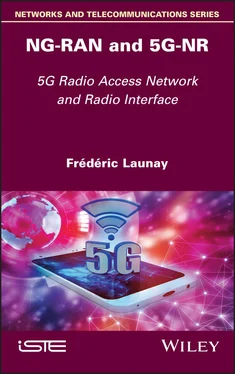If the mobile is in the RRC_CONNECTED state, connected with the NG-RAN node, then several radio identities are used per mobile:
1 – C-RNTI (Cell): unique identification of the mobile for the RRC connection and for scheduling;
2 – CS-RNTI (Configured Scheduling): radio identifier of the mobile for the RRC connection and for semi-persistent scheduling;
3 – SP-CSI-RNTI (Semi-Persistent): radio identifier of the mobile used for the transmission of radio channel information (CSI: Channel State Information) on the uplink traffic channel with semi-persistent scheduling;
4 – MCS-RNTI (Modulation Coding Scheme): radio identifier of the mobile to indicate the modulation and coding scheme (MCS) of the mobile for the transmission of data on the downlink and uplink traffic links;
5 – TPC-RNTI (Transmit Power Control RNTI) is used to retrieve the information corresponding to the power control for both the traffic and uplink control channels.
1.3.2. Mobile mobility
1.3.2.1. Mobility in the idle mode
When the mobile is in the idle state, it is located by the AMF from the TAI (Tracking Area Identity) value.
The mobile listens to the broadcast information and to the paging information sent by the NG-RAN node.
If the mobile is in the discontinuous reception mode (DRX), the frame that carries the paging notification is calculated from the 5G-identity S-TMSI of the UE modulo 1024.
The mobile becomes aware of the paging when the content of the paging message carries the 5G-S-TMSI identifier or the I-RNTI identifier of the mobile.
The mobile informs the AMF of a change of tracking zone when it falls under the coverage of a radio node whose TAI is different from the previous TAI coverage zone.
The selection or reselection of cells is based on the transmitted synchronization signal CD-SSB (Cell Defining Synchronization Signal and PBCH Block) specific to each cell.
1.3.2.2. Mobility in RRC_Inactive
The mobile is in the RRC_INACTIVE state for the NG-RAN and in the CM_CONNECTED state for the 5G core network. The mobile context is always stored on the node where the mobile was connected.
The mobile can move in the RAN Notification Area (RNA) without notifying the NG-RAN nodes. An RNA zone comprises one or several cells located in the same TAI zone.
In the case of mobile terminating data, the UPF transfers the packet to the last NG-RAN node on which the mobile had established a radio connection. The NG-RAN node broadcasts a paging request over the air interface and transmits (through the Xn interface) a paging order to neighboring NG-RAN nodes that are configured on the same RNA area. If the paging request fails (the mobile is not reachable), then the NG-RAN node informs the AMF.
If the mobile establishes a radio connection with an NG-RAN node other than the last serving node, then the new NG-RAN node initiates a procedure to retrieve the context of the mobile UE from the old serving node. In the case where the request fails, the NG-RAN node triggers a new RRC connection.
1.3.2.3. Mobility in the RRC_Connected state
When the mobile is in the RRC_CONNECTED state and CM_CONNECTED state, its mobility is controlled by the NG-RAN node via the handover mechanism between a source radio node and a target radio node, or between two beams of the same radio node.
In the case of a handover, the NG-RAN node exchanges RRC signaling with the mobile. There are several types of handover:
1 – on the Xn interface between two neighboring connected nodes;
2 – on the NG interface with the UPF.
In the case of beam-based coverage, the beam selection is carried out at the MAC (Medium Access Control) layer of the mobile from mobile measurements. No RRC signaling occurs when the beam is changing since the mobile was configured at the beginning of the radio connection in terms of the measurements to be carried out (Measurement Objects).
The mobile makes radio measurements on one or more beams of a cell and determines:
1 – the radio quality of the beam by filtering the measurements on the L1 layer;
2 – the quality of the radio link of the cell by averaging the measurement of the different beams at the level of the L3-RRC layer.
The mobile also carries out measurements on the quality of the SSB block (Synchronization Signal and Broadcast) of the beams under the coverage of the cell, and also the quality of the neighboring intra- and inter-band cells. Each SSB measurement is seen by the mobile as a different cell.
Table 1.1summarizes the different cases.
Table 1.1. RRC mobile states
| RRC_IDLE |
RRC_INACTIVE |
RRC_CONNECTED |
| Cell selection is controlled by the UE in the function of radio access network parameters (AS: Access Stratum). |
UE mobility is known by the core network.The core network knows the identity of the radio node with which the terminal is connected. |
| The UE listens to broadcast signal. |
| Paging notifications are initiated by the core network. |
Paging notifications are initiated by the NG-RAN node. |
| The mobile has a temporary identity created by the core network.No UE context is stored on the NG-RAN node. |
The NG-RAN node knows the RNA location area on which the mobile is camped |
| The mobile radio context is stored at the mobile side and the NG-RAN node side. The core network and the NG-RAN node exchange information through NG-C and NG-U interfaces. |
1.4. Scheduling and QoS
1.4.1. Scheduling
Scheduling enables us to share radio resources among all connected users. A scheduling task is performed in real time to share radio resources among all mobiles. Scheduling attribution is calculated based on:
1 – the quality of the radio link for each mobile;
2 – requirements in terms of the quality of service expected by each mobile;
3 – the state of the mobile buffer.
The scheduler is performed at the MAC layer of the NG-RAN node and defines the scheduling for downlink and uplink transmissions.
The quality of the radio link is used to define the modulation and coding scheme (MCS) for a given mobile, as well as the transmission power. The MCS is dynamically adjusted according to the HARQ (Hybrid Automatic Repeat Request) retransmission rate.
To meet mobile requirements, several strategies can be defined at the scheduler level:
1 – fairness, a strategy for which each mobile receives the same resource allocation regardless of the modulation scheme;
2 – proportional fairness which allocates more frequency resources for mobiles with less efficient MCS;
3 – round-robin, a strategy which consists of allocating equal resources to all mobiles;
4 – max-CQI, a strategy that aims to maximize cell capacity by prioritizing the allocation of radio resources to mobiles which have the best radio quality.
The scheduler is based on measurement reports:
1 – the state of the buffer BSR (Buffer Status Report);
2 – the quality of the radio link (CSI-RS);
3 – the rising power margin PHR (Power Headroom Reports);
4 – Inter-Cell Interference Coordination (ICIC) between NG-RAN nodes.
From this information, the scheduler defined:
1 – the frequency radio resources to be allocated for each mobile;
2 – the number of spatial layers that can be used, depending on the category of the mobile;
3 – the transmission TTI (Time Transmission Interval) instants.
The mobile listens to the information transmitted over the PDCCH (Physical Downlink Control Channel) logical control channel and decodes the information channel when it detects its radio identifier C-RNTI.
Читать дальше












